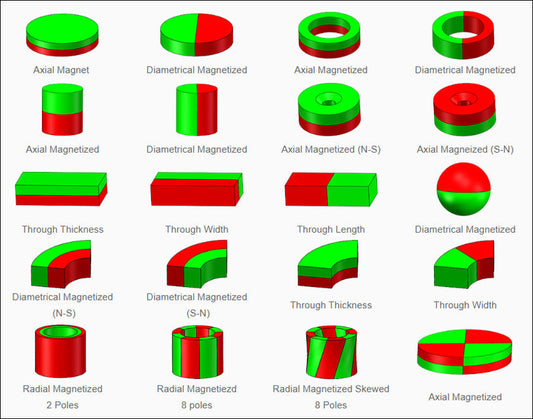Magnets are widely used across industries, from everyday household products to advanced industrial applications. At the heart of their functionality lies a simple yet powerful concept — the poles of magnets. Understanding magnetic poles is essential for anyone working with permanent magnets, as they define how and where a magnet exerts its force.
What are Magnetic Poles?
Magnets have two distinct ends called poles, where the magnetic field is strongest. These are known as:
- North Pole (N): The end that points towards the Earth’s geographic north when suspended freely.
- South Pole (S): The end that points towards the Earth’s geographic south.
Magnetic poles always exist in pairs — if you cut a magnet in half, each piece will still have both a north and a south pole.
Key Characteristics of Magnetic Poles
1.Poles Come in Pairs: A single isolated pole (called a monopole) does not exist in nature.
2.Opposite Poles Attract: North and south poles pull towards each other.
3.Like Poles Repel: Two north poles or two south poles push away from each other.
4.Field Strength is Maximum at Poles: The strongest magnetic force is concentrated at the poles.
Why are Poles of Magnets Important?
The position of magnetic poles determines how magnets interact with materials and devices. For engineers, product designers, and manufacturers, understanding pole orientation ensures:
- Efficient Design: Correct alignment maximizes magnetic performance.
- Accurate Functionality: Essential in motors, sensors, and medical devices.
- Reliable Applications: From holding systems to advanced electronics, pole orientation is critical.
Types of Pole Arrangements
Depending on the magnet’s shape and magnetization, poles can be arranged in different ways:
1.Axial Poles: Found on the flat faces of cylindrical or disc magnets.
2.Radial Poles: Located around the circumference of a ring magnet.
3.Diametric Poles: Found on opposite curved sides of a cylindrical magnet.
4.Multipole Arrangement: Several north and south poles distributed on one surface, often used in encoders and magnetic strips.
Applications of Magnetic Poles
- Motors & Generators: Use alternating north and south poles for smooth energy conversion.
- Medical Equipment: MRI machines and precision devices rely on accurate pole orientation.
- Consumer Electronics: Speakers, headphones, and sensors use carefully positioned poles.
- Industrial Uses: Lifting magnets, clamping systems, and magnetic separators utilize pole strength for efficiency.
Final Thoughts
The poles of magnets are not just physical ends of a magnet — they are the foundation of magnetic behavior and performance. By understanding pole orientation and arrangement, industries can design better products, improve efficiency, and achieve greater precision.
At Magnetyz, we manufacture and supply magnets with customized pole orientations to meet the exact needs of your applications


